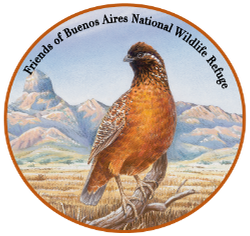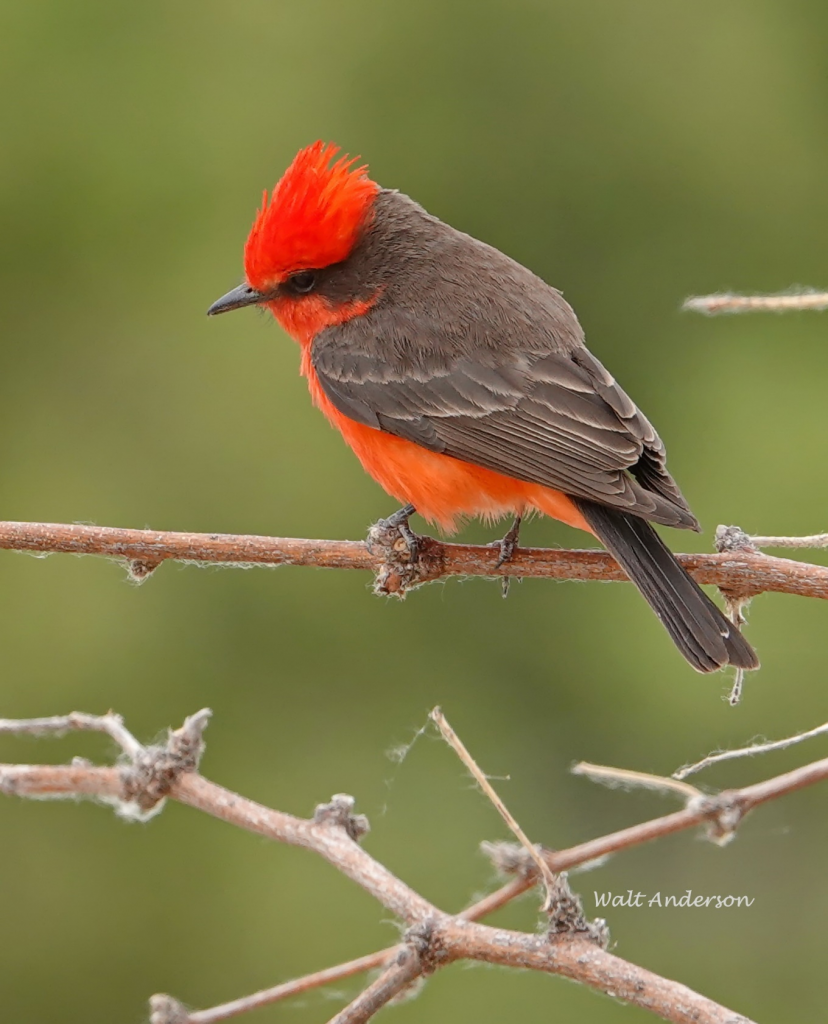
Wild Wednesday. 30 March 2022. Thanks Vermilion!
by Walt Anderson
On the voyage of the Beagle, Darwin was given the nickname “Flycatcher” for his skills at collecting specimens. To us, the word “flycatcher” seems obvious—a bird that catches flies. But as I have often cautioned, names can be deceiving. If you lived in Europe, Asia, or Africa, “flycatcher” would mean a member of the Muscicapidae, a large family of true songbirds collectively known as “chats, robins, and Old World Flycatchers.” Ironically, these are not closely related to what we in North America would call “chats, robins, and flycatchers.” Our Yellow-breasted Chat used to be considered a “New World Warbler,” though now it is in a family of its own, more closely related to blackbirds, orioles, and meadowlarks than to our “warblers.” Our “robin” is in the Turdidae, just superficially similar to the muscicapid robins of the Old World. And our “flycatchers” are in an entirely different major group, the suboscines, which have programmed, genetically predetermined songs, not learned like those of the true songbirds, the oscines. Ornithologists refer to our flycatchers as members of the Tyrannidae, the tyrant-flycatchers, based on the tyrannical behaviors of kingbirds and some other members of that group. Most tyrant-flycatchers are drab, males and females similar and sometimes devilishly difficult to tell from closely related species. One flycatcher stands out—the very opposite of drab and tyrannical—the Vermilion Flycatcher.

The genus Pyrocephalus means “fire head,” and that certainly applies to the brilliant colors of the male Vermilion Flycatcher, not to any hot-headed tendencies. Its range includes extreme southern California through the southern half of Arizona, New Mexico, and Texas; Mexico; and three major populations in South America, avoiding higher altitudes and latitudes and the dense tropical rainforest.
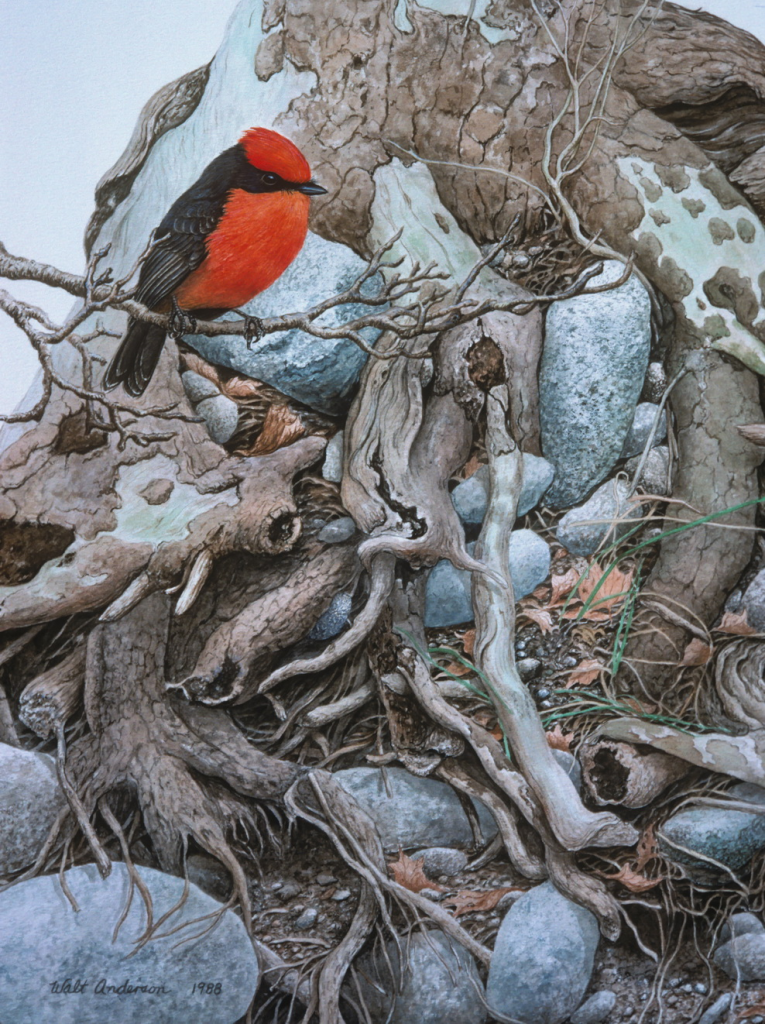
Vermilion Flycatchers prefer open country for foraging, and in the US, they favor rather open cottonwood-willow or sycamore associations and mesquite bosques. They prefer to be near water, so they have adapted well to urban and rural oases such as golf courses, city parks, and farms or ranches that meet their needs. Gentle and beautiful, they are favorites of most people who have them as neighbors. I grew up north of Seattle, definitely not Vermilion Flycatcher habitat, so when I came to Arizona to pursue my Master’s degree at the University of Arizona, I too fell in love with them.
I did this detailed watercolor of a flycatcher among sycamore roots many years ago, and it remains among my favorites. This past week I returned to southern Arizona and was thrilled to see dozens of these birds and to deliver another painting (shared near the end of this essay) to someone else who is passionate about this bird.

Let’s face it—bold is beautiful in a flycatcher that breaks so dramatically from its fairly conservative tyrannid relatives. Like most of its kin, it is a sit-and-wait predator, perched most of the day and sallying out periodically to snatch an insect flying by or dropping to the ground to seize a grasshopper or spider. The showy male performs spectacular aerial displays, shooting up high, fluttering like a butterfly with alternating flaps and stalls. It gives a high-pitched, almost tinkling song described as “t-t-ti-ti-tee-teeur.” His mate, much less colorful, must be impressed, and they set up nest-keeping for that season.
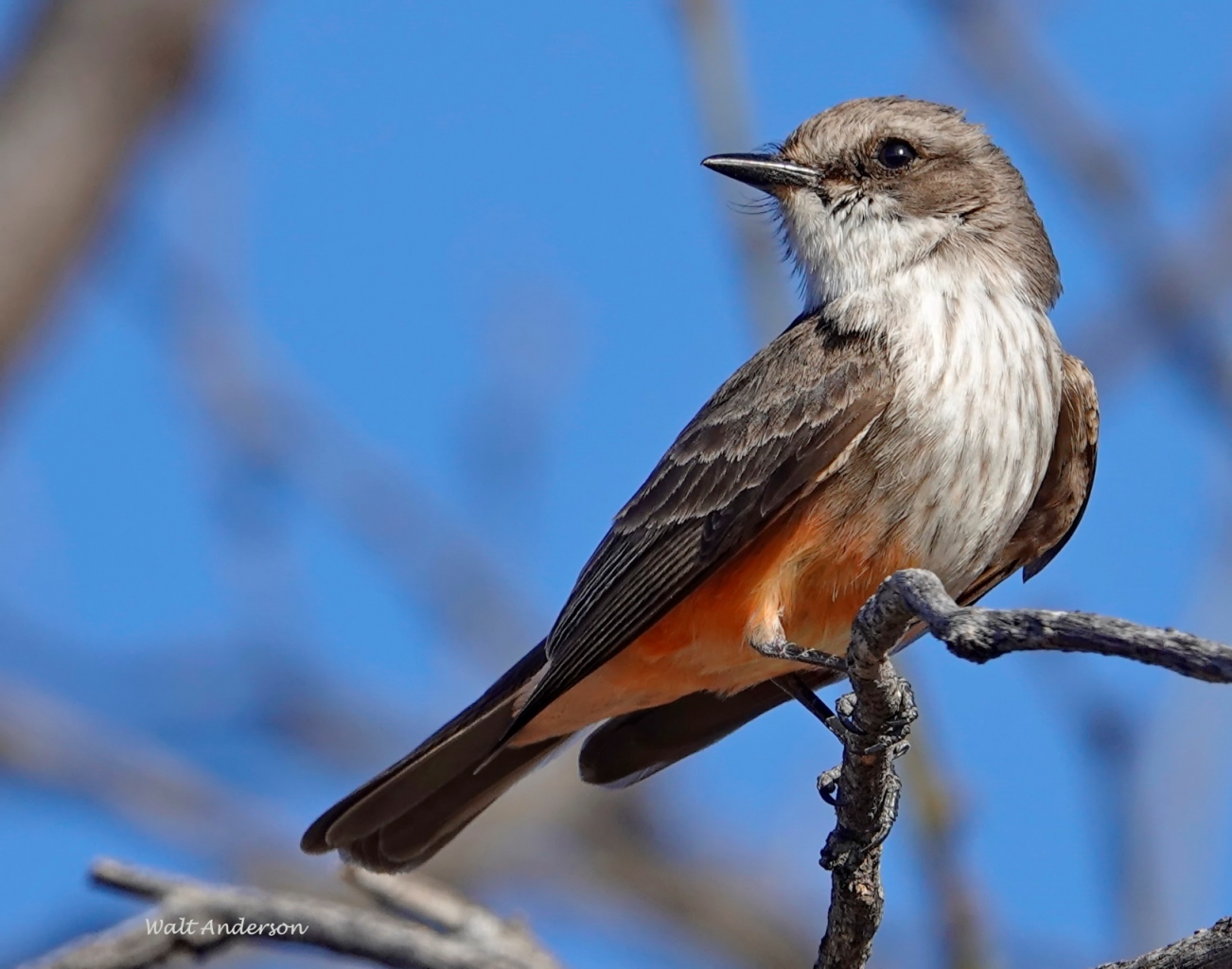
The female is lovely in her own right, though plain enough above to be less conspicuous when sitting on the open nest. Like most tyrannids, she has a flat, fairly broad beak ideal for snatching insect prey out of the air, along with fine rictal bristles around the base of the bill. In the northern and extreme southern parts of her range, she is migratory, avoiding the cold (which dampens insect abundance, as well), but in the central part of the species’ range, the birds are permanent residents. The migratory birds tend to have longer wings than the sedentary ones do—good support for Darwin’s evolutionary mechanism of natural selection. I am sure that Darwin saw and admired these birds in what are now southern Brazil, Uruguay, and northern Argentina, and he saw what appeared to be the same species in the Galapagos, far west of the South American coast. DNA analyses have now determined that the Galapagos birds were isolated there long enough to have become a different species, the Brujo Flycatcher. It got its name from the local descriptor, “pajaro brujo,” the witch bird. I have no idea how this innocent bird got such a name, for in Mexico, a “witch bird” is an owl, often assumed to be an omen of death. Why should the Galapagos variant be associated with the supernatural? Well, if drab is natural for most tyrannid flycatchers, then perhaps the brilliance of the male might be taken as super-natural. Or maybe this unusually colorful bird is simply bewitching.
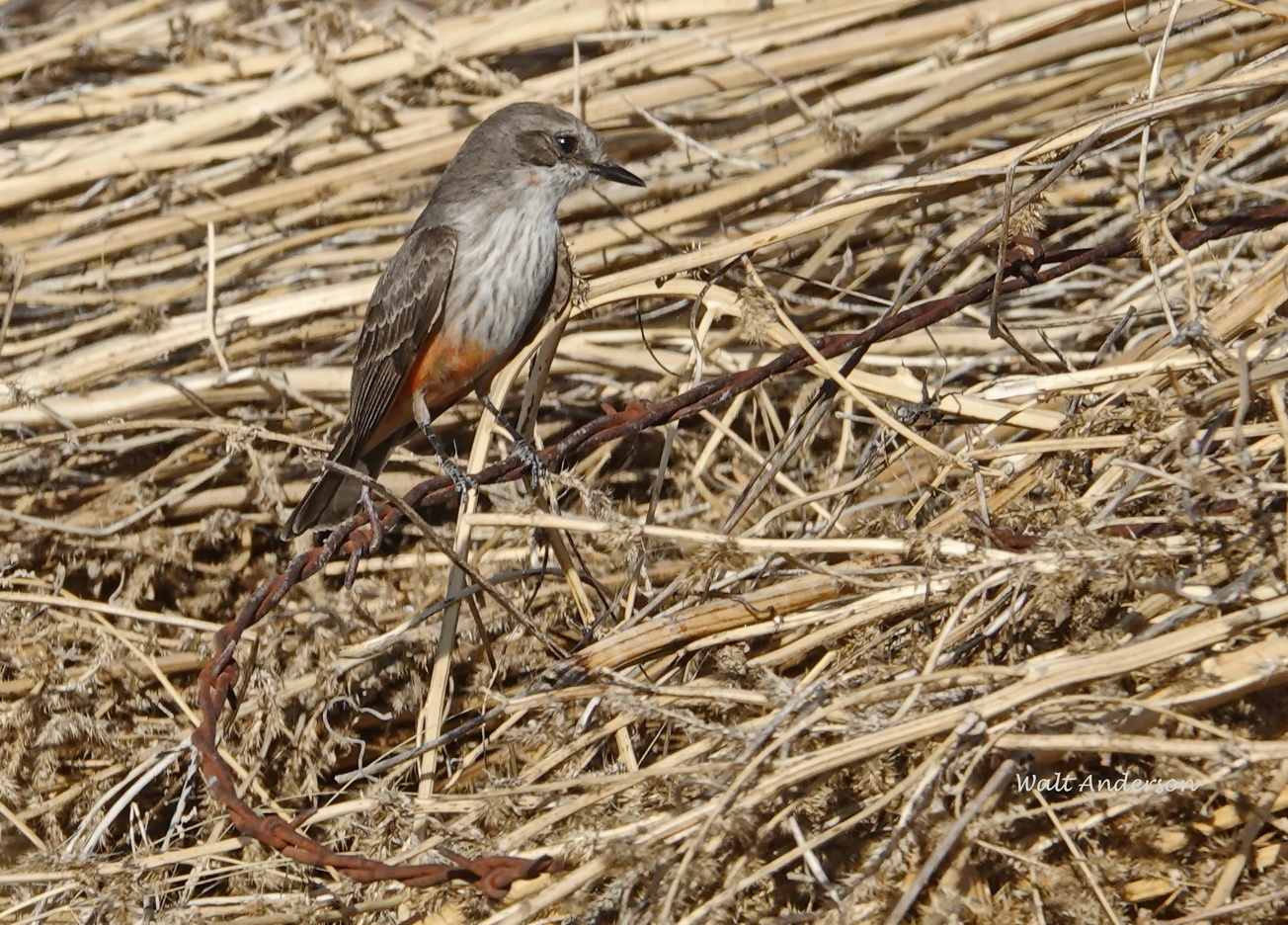
A few days ago, I was lucky enough to watch a female Vermilion Flycatcher building her nest. She would fly to a low perch, like this rusted barbed wire, and scan the straw and weed fragments for something that would make a good nest furnishing. Then she would fly down to snatch it, then ascend to her chosen home in a mesquite.
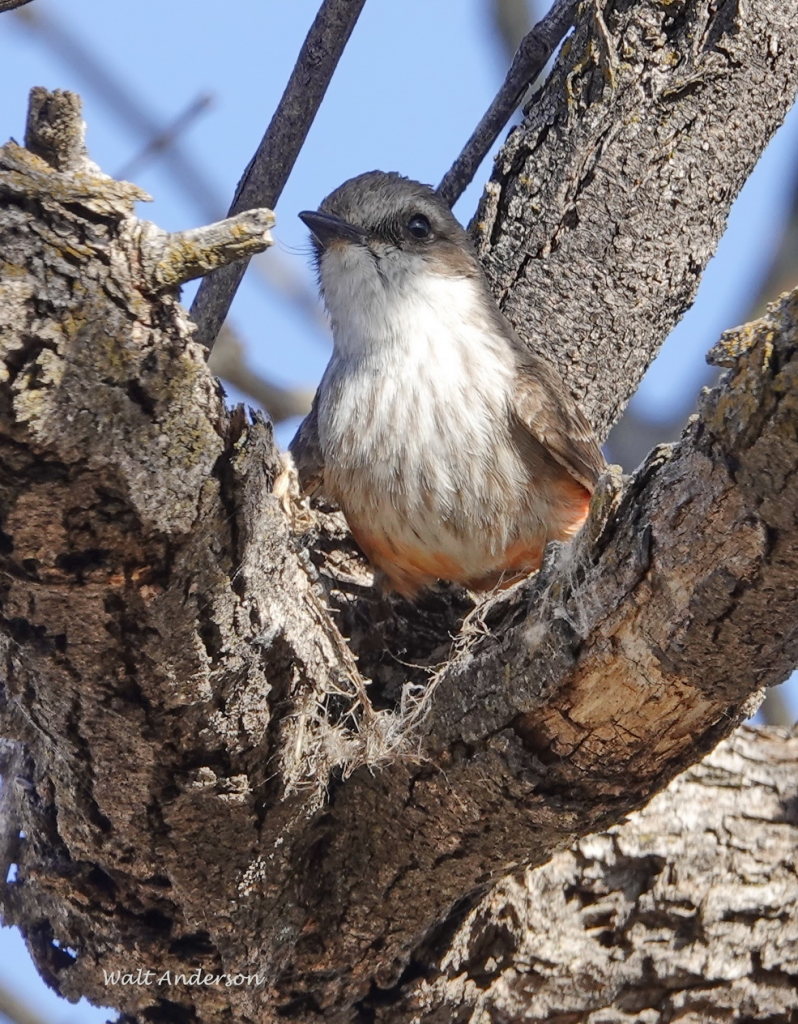
How lucky I was to witness this female building her nest! It’s typical for a male to choose a potential site, displaying on it through wiggle-moves, chattering, and slight wing-fluttering over his back. He may tempt his mate with a delicious morsel through courtship feeding. She builds the nest without his help. Birds of the World describes the nest this way: “Somewhat frail, loosely constructed, shallow cup of small twigs, forbs, rootlets, grasses, fibers, and empty cocoons; lined with down, feathers, and hair.” She often uses spider webbing to hold it all together snuggly. She’ll lay 2-4 eggs (average 3) and incubate them for about two weeks. Newly hatched nestlings are fed by both parents until fledging a couple weeks later. The female may initiate a new nest, and studies have shown that some of her eggs have been fertilized by someone other than the father, who may have been feeding the fledglings while she was sneaking around. Best to keep this information to yourself!

Cowbirds, often subsidized by food available at farms and ranches, can reduce flycatcher nest success through nest parasitism. Habitat loss (e.g., groundwater pumping reducing the extent of riparian trees) and land “development” are considered to be threats to Vermilion Flycatcher populations, and climate change is also likely to reduce habitat. Ironically, though this is a widespread, conspicuous, and relatively “tame” bird to observe, there is still much to be learned about its life history. Bird grad students—pay attention!
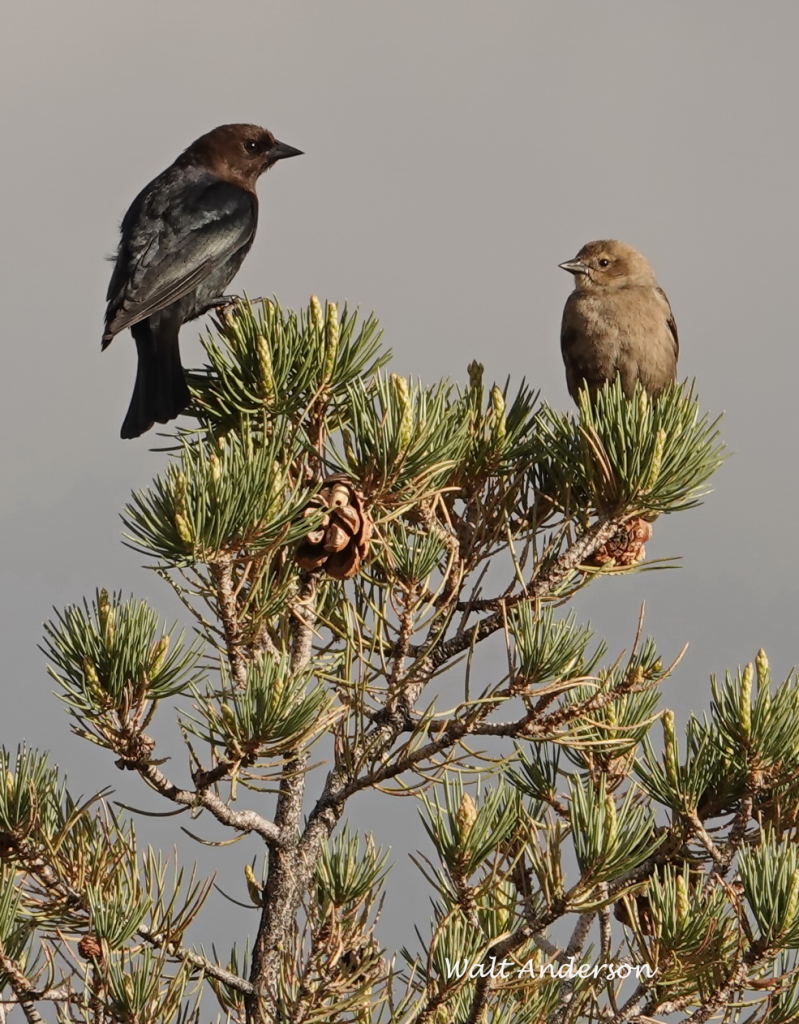
During the past month, I did two Vermilion Flycatcher paintings. Lack of time precluded the creation of a really ambitious piece like the one shown earlier with the sycamore roots. On this one, only 5 x 12 inches, I focused on delicate detail. On the original, you would need a magnifying glass to see some of the features I added. It’s still available and very affordable, so contact me if interested.
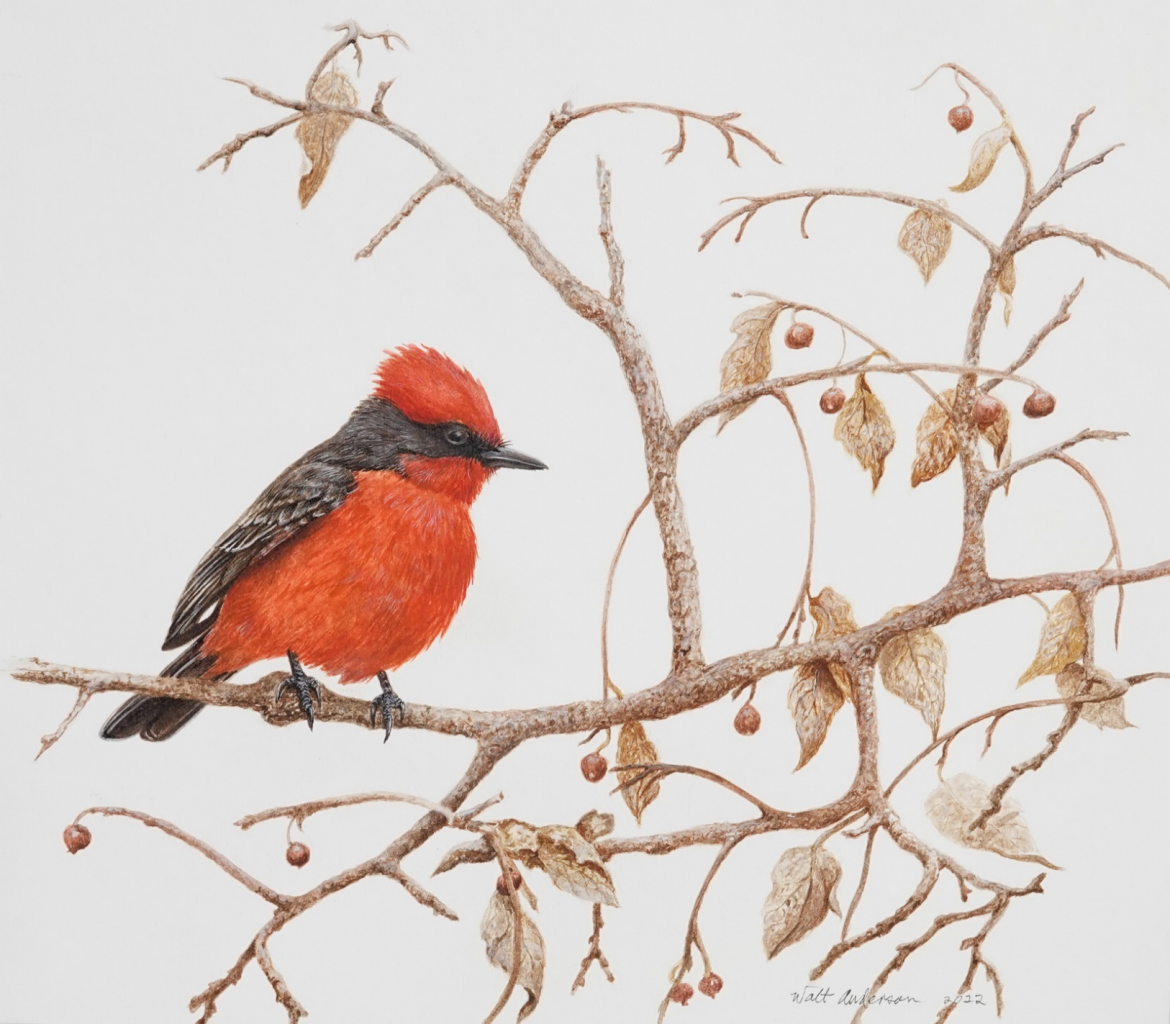
This one (13 x 11.5”) took a lot more time to create, especially to design the hackberry branches and leaves to complement the bird. One of my former students, currently living in Tucson, now owns this piece so he can revive memories of his field sightings of this species while he is slaving over a hot computer.
Golf courses have major negative environmental impacts, including considerable use of our diminishing water supplies, but Vermilion Flycatchers in the Southwest may be one of the more common birdies out there. Much better than a bogey!
I appreciate those of you who like my photo essays. Thanks Vermilion!
